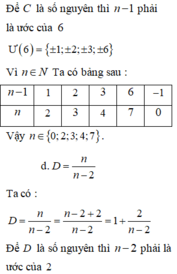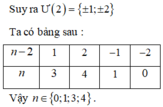


Hãy nhập câu hỏi của bạn vào đây, nếu là tài khoản VIP, bạn sẽ được ưu tiên trả lời.




-bạn tự lập bảng nhé
a, \(3n-1\inƯ\left(12\right)=\left\{\pm1;\pm2;\pm3;\pm4;\pm6;\pm12\right\}\)
b, \(\dfrac{2\left(n-3\right)+11}{n-3}=2+\dfrac{11}{n-3}\Rightarrow n-3\inƯ\left(11\right)=\left\{\pm1;\pm11\right\}\)
| n-3 | 1 | -1 | 11 | -11 |
| n | 4 | 2 | 14 | -8 |
c, \(\dfrac{3n}{n+2}=\dfrac{3\left(n+2\right)-6}{n+2}=3-\dfrac{6}{n+2}\Rightarrow n+2\inƯ\left(6\right)=\left\{\pm1;\pm2;\pm3;\pm6\right\}\)


a) ĐKXĐ: \(n\ne3\)
Để phân số \(A=\dfrac{n-5}{n-3}\) là số nguyên thì \(n-5⋮n-3\)
\(\Leftrightarrow n-3-2⋮n-3\)
mà \(n-3⋮n-3\)
nên \(-2⋮n-3\)
\(\Leftrightarrow n-3\inƯ\left(-2\right)\)
\(\Leftrightarrow n-3\in\left\{1;-1;2;-2\right\}\)
hay \(n\in\left\{4;2;5;1\right\}\)
Vậy: \(n\in\left\{4;2;5;1\right\}\)

\(a,3n-1\inƯ\left(12\right)=\left\{\pm1;\pm2;\pm3;\pm4;\pm6;\pm12\right\}\)
| 3n-1 | 1 | -1 | 2 | -2 | 3 | -3 | 4 | -4 | 6 | -6 | 12 | -12 |
| n | loại | 0 | 1 | loại | loại | loại | loại | -1 | loại | loại | loại | loại |
c, \(\dfrac{2\left(n-3\right)+9}{n-3}=2+\dfrac{9}{n-3}\Rightarrow n-3\inƯ\left(9\right)=\left\{\pm1;\pm3;\pm9\right\}\)
| n-3 | 1 | -1 | 3 | -3 | 9 | -9 |
| n | 4 | 2 | 6 | 0 | 12 | -6 |